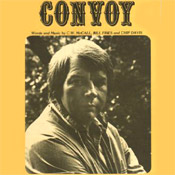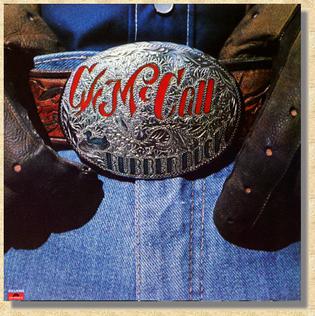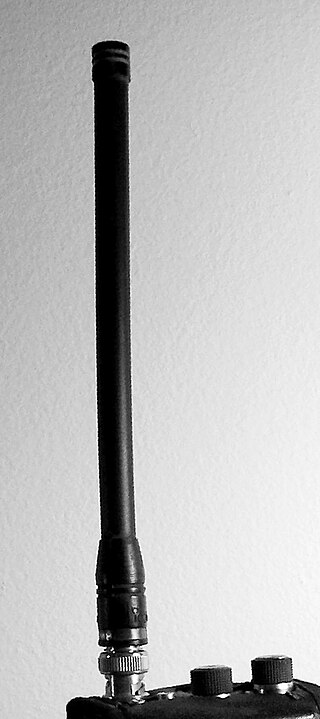A rainbow is a meteorological phenomenon that appears as a multicolored arc that forms with the sunlight reflecting water.

William Dale Fries Jr. was an American commercial artist who won several Clio Awards for his advertising campaigns. He was also a musician and is best known for his character C. W. McCall, a truck-driving country singer that he originally created for a series of bread commercials. Fries performed as McCall in a series of outlaw albums and songs in the 1970s, in collaboration with co-worker Chip Davis who also founded Mannheim Steamroller.

A rubber duck or a rubber duckie is a toy shaped like a duck, that is usually yellow with a flat base. It may be made of rubber or rubber-like material such as vinyl plastic. Rubber ducks were invented in the late 1800s when it became possible to more easily shape rubber, and are believed to improve developmental skills in children during water play.
Jet, Jets, or The Jet(s) may refer to:
A mallard is a type of duck.
Ducky is a nickname and fictional character given name. It may refer to:
Duck is a name applied to several bird species of the family Anatidae.

"Convoy" is a 1975 novelty song performed by C. W. McCall that became a number-one song on both the country and pop charts in the US and is listed 98th among Rolling Stone magazine's 100 Greatest Country Songs of All Time. Written by McCall and Chip Davis, the song spent six weeks at number one on the country charts and one week at number one on the pop charts. The song went to number one in Canada as well, hitting the top of the RPM Top Singles Chart on January 24, 1976. "Convoy" also peaked at number two in the UK. The song capitalized on the fad for citizens band (CB) radio. The song was the inspiration for the 1978 Sam Peckinpah film Convoy, for which McCall rerecorded the song to fit the film's storyline.

Rubber Duck is an album by country musician C. W. McCall, released on Polydor Records in 1976. It is his fourth album, released the same year as Wilderness, but concentrating on the themes the McCall character was popular for – trucking, as opposed to the various depictions of nature that could be found in Wilderness. Among others, the album contains the song "'Round the World with the Rubber Duck", a sequel to McCall's earlier wildly popular hit "Convoy", with many humorous and absurd elements added. "Audubon" is a quasi-autobiographical song, while "Ratchetjaw" is a take on trucker slang, with a multitude of CB-related terminology included in the lyrics.
Plastic is a polymerized material. It may also refer to:

Friendly Floatees are plastic bath toys marketed by The First Years and made famous by the work of Curtis Ebbesmeyer, an oceanographer who models ocean currents on the basis of flotsam movements. Ebbesmeyer studied the movements of a consignment of 28,800 Friendly Floatees—yellow ducks, red beavers, blue turtles, and green frogs—that were washed into the Pacific Ocean in 1992. Some of the toys landed along Pacific Ocean shores, such as Hawaii. Others traveled over 27,000 kilometres (17,000 mi), floating over the site where the Titanic sank, and spent years frozen in Arctic ice before reaching the U.S. Eastern Seaboard as well as British and Irish shores, fifteen years later, in 2007.

The rubber ducky antenna is an electrically short monopole antenna that functions somewhat like a base-loaded whip antenna. It consists of a springy wire in the shape of a narrow helix, sealed in a rubber or plastic jacket to protect the antenna. The rubber ducky antenna is a form of normal-mode helical antenna.
Pioneer commonly refers to a settler who migrates to previously uninhabited or sparsely inhabited territory.

An inverted-F antenna is a type of antenna used in wireless communication, mainly at UHF and microwave frequencies. It consists of a monopole antenna running parallel to a ground plane and grounded at one end. The antenna is fed from an intermediate point a distance from the grounded end. The design has two advantages over a simple monopole: the antenna is shorter and more compact, allowing it to be contained within the case of the mobile device, and it can be impedance matched to the feed circuit by the designer, allowing it to radiate power efficiently, without the need for extraneous matching components.
This page is based on this
Wikipedia article Text is available under the
CC BY-SA 4.0 license; additional terms may apply.
Images, videos and audio are available under their respective licenses.






